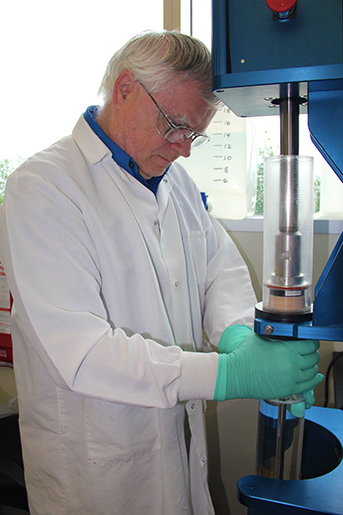


Many of the food-borne and water-borne pathogens that were in the news last year were part of Hygienic Laboratory testing. Cryptosporidium and Cyclospora parasites, Salmonella, E.coli O157:H7 and Listeria monocytogenes were some of the headliners during fiscal year 2015.
Environmental Microbiology is the study of microorganisms – fungi, bacteria and viruses – in the environment. Microorganisms are abundant and essential in the environment, but some are harmful to humans. Microbial contaminants that infiltrate our natural resources or food supply can lead to widespread illness.
The Environmental Microbiology section provides analytical services to detect potentially harmful microorganisms in food, water and soil. Such analyses are used in outbreak investigations to pinpoint the source of contamination and to assess the environmental impact from exposure to microbial contaminants. Confirmation of exact microorganism strains is critical in implementing appropriate remediation.
Laboratory testing is provided in support of statewide water surveillance programs to assess the overall safety of public and private drinking water supplies, surface waters (lakes and ponds), and recreational waters (pools and spas). Pathogen analyses in water, food and environmental samples are expanding with emphasis on Cryptosporidium, Legionella, Salmonella and Listeria.
- Became certified to perform Cryptosporidium testing in support of the EPA Long Term 2 Enhanced Surface Water Treatment Rule Round 2. The laboratory was awarded the state of Missouri’s Cryptosporidium testing contract (five years) for this rule. This rule and supporting surveillance activities were developed to reduce disease incidence associated with this parasite and other disease-causing microorganisms in drinking water.
- Confirmed the source of a foodborne outbreak in Johnson County so remediation could be initiated and further illness prevented. Environmental surface samples taken from the suspected facility were proven to have the same Salmonella Enteritidis strain found in clinical specimens.
- Tested more than 500 beach sand samples from three Iowa beaches for measurement of E.coli per dry weight gram. These samples were submitted by the Iowa Department of Natural Resources to try to pinpoint the source of contamination in recreational waters.
- Developed a sampling plan with the Iowa Department of Inspection and Appeals (IDIA) as part of the FDA ISO17025 food accreditation requirement. Samples from such products as apple cider, gelatin, salsa, ice, bottled water, fish and environmental sponges were collected by IDIA from food manufacturing facilities across Iowa to be tested throughout the year for a variety of microbiological contaminants, including Salmonella, E.coli O157:H7, Listeria monocytogenes, coliform bacteria and E.coli.
- Developed two new molecular assays for the detection of Cryptosporidium and Cyclospora parasites which were used to test about 200 fresh produce and herb samples from retail and farmers markets in Iowa.



